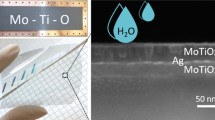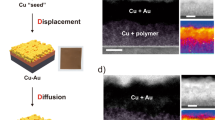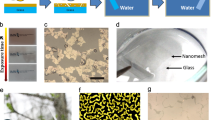Abstract
Dielectric/metal/dielectric (DMD) transparent electrodes emerged as a compelling alternative to the widely used indium-tin-oxide (ITO) for solar cells and optoelectronic devices. DMD electrodes are especially attractive for flexible substrates, as, in contrast to ITO, they retain their low electrical resistance upon substrate bending and they do not require deposition at elevated temperatures. In a DMD, the choice of the dielectric is mainly dictated by the device architecture. Owing to its high work function, MoO3 is a commonly used hole-selective dielectric layer. The present work investigates MoOx/metal/MoOx (with 2 < x < 3) DMD electrodes, with Ag and Au as metals, fabricated by direct current, magnetron sputtering, at industry-relevant, high deposition rates. This was possible with a properly engineered MoOx target, providing high electrical conductivity and compactness. The sputtered electrodes on polyethylene terephthalate (PET) substrates show higher figure-of-merit than similar, evaporated electrodes in the literature. It is shown that the DMD electrodes with amorphous MoOx layers have low stability in water, but they are stable to other solvents, such as toluene, dimethylsulfoxide (DMSO), dimethylformamide (DMF), chlorobenzene or chloroform, allowing their implementation in devices like organic light-emitting diodes or perovskite solar cells. Further, it is shown that the electrodes show dramatically enhanced mechanical stability compared to ITO, when subjected to tensile bending tests.
Graphical abstract
















Similar content being viewed by others
References
Brabec CJ, Scherf U, Dyakonov V (2014) Organic photovoltaics: materials, device physics, and manufacturing technologies, 2nd edn. Wiley-VCH-Verl, Weinheim
Zilberberg K, Riedl T (2016) Metal-nanostructures–a modern and powerful platform to create transparent electrodes for thin-film photovoltaics. J Mater Chem A 4:14481–14508. https://doi.org/10.1039/C6TA05286J
Lewis J, Grego S, Chalamala B et al (2004) Highly flexible transparent electrodes for organic light-emitting diode-based displays. Appl Phys Lett 85:3450–3452. https://doi.org/10.1063/1.1806559
Guillén C, Herrero J (2011) TCO/metal/TCO structures for energy and flexible electronics. Thin Solid Films 520:1–17. https://doi.org/10.1016/j.tsf.2011.06.091
Dimopoulos T, Bauch M, Wibowo RA et al (2015) Properties of transparent and conductive Al:ZnO/Au/Al:ZnO multilayers on flexible PET substrates. Mater Sci Eng B 200:84–92. https://doi.org/10.1016/j.mseb.2015.06.008
Szczyrbowski J, Dietrich A, Hartig K (1989) Bendable silver-based low emissivity coating on glass. Sol Energy Mater 19:43–53. https://doi.org/10.1016/0165-1633(89)90022-1
Szczyrbowski J, Bräuer G, Ruske M et al (1999) New low emissivity coating based on TwinMag® sputtered TiO2 and Si3N4 layers. Thin Solid Films 351:254–259. https://doi.org/10.1016/S0040-6090(99)00086-3
Lee MH, Choi WH, Zhu F (2016) Solution-processable organic-inorganic hybrid hole injection layer for high efficiency phosphorescent organic light-emitting diodes. Opt Express 24:A592. https://doi.org/10.1364/OE.24.00A592
Fan X, Cui C, Fang G et al (2012) Efficient Polymer Solar Cells Based on Poly(3-hexylthiophene):Indene-C70 Bisadduct with a MoO3 Buffer Layer. Adv Funct Mater 22:585–590. https://doi.org/10.1002/adfm.201102054
Hou F, Su Z, Jin F et al (2015) Efficient and stable planar heterojunction perovskite solar cells with an MoO3/PEDOT:PSS hole transporting layer. Nanoscale 7:9427–9432. https://doi.org/10.1039/C5NR01864A
Kinner L, Hermerschmidt F, Dimopoulos T, List-Kratochvil EJW (2020) Implementation of flexible embedded nanowire electrodes in organic light-emitting diodes. Phys Status Solidi RRL–Rapid Res Lett 14:2000305. https://doi.org/10.1002/pssr.202000305
Gong Y, Dong Y, Zhao B et al (2020) Diverse applications of MoO3 for high performance organic photovoltaics: fundamentals, processes and optimization strategies. J Mater Chem A 8:978–1009. https://doi.org/10.1039/C9TA12005J
Meyer J (2011) Electronic structure of molybdenum-oxide films and associated charge injection mechanisms in organic devices. J Photonics Energy 1:011109. https://doi.org/10.1117/1.3555081
Battaglia C, Yin X, Zheng M et al (2014) Hole Selective MoOx Contact for Silicon Solar Cells. Nano Lett 14:967–971. https://doi.org/10.1021/nl404389u
Thibau ES, Llanos A, Lu Z-H (2017) Disruptive and reactive interface formation of molybdenum trioxide on organometal trihalide perovskite. Appl Phys Lett 110:081604. https://doi.org/10.1063/1.4976697
Cauduro F, dos Reis AL, Chen R et al (2017) Crystalline molybdenum oxide thin-films for application as interfacial layers in optoelectronic devices. ACS Appl Mater Interfaces 9:7717–7724. https://doi.org/10.1021/acsami.6b14228
Carcia PF, McCarron EM (1987) Synthesis and properties of thin film polymorphs of molybdenum trioxide. Thin Solid Films 155:53–63. https://doi.org/10.1016/0040-6090(87)90452-4
Dukstiene N, Sinkeviciute D, Guobiene A (2012) Morphological, structural and optical properties of MoO2 films electrodeposited on SnO2∣glass plate. Open Chem 10:1106–1118. https://doi.org/10.2478/s11532-012-0012-7
Moosburger-Will J, Kündel J, Klemm M et al (2009) Fermi surface of MoO2 studied by angle-resolved photoemission spectroscopy, de Haas–van Alphen measurements, and electronic structure calculations. Phys Rev B 79:115113. https://doi.org/10.1103/PhysRevB.79.115113
Inzani K, Nematollahi M, Vullum-Bruer F et al (2017) Electronic properties of reduced molybdenum oxides. Phys Chem Chem Phys 19:9232–9245. https://doi.org/10.1039/C7CP00644F
de Castro IA, Datta RS, Ou JZ et al (2017) Molybdenum oxides-from fundamentals to functionality. Adv Mater 29:1701619. https://doi.org/10.1002/adma.201701619
Scanlon DO, Watson GW, Payne DJ et al (2010) Theoretical and experimental study of the electronic structures of MoO3 and MoO2. J Phys Chem C 114:4636–4645. https://doi.org/10.1021/jp9093172
Shafaei S, Van Opdenbosch D, Fey T et al (2016) Enhancement of the antimicrobial properties of orthorhombic molybdenum trioxide by thermal induced fracturing of the hydrates. Mater Sci Eng C 58:1064–1070. https://doi.org/10.1016/j.msec.2015.09.069
Rempel KU, Williams-Jones AE, Migdisov AA (2008) The solubility of molybdenum dioxide and trioxide in HCl-bearing water vapour at 350 °C and pressures up to 160 bars. Geochim Cosmochim Acta 72:3074–3083. https://doi.org/10.1016/j.gca.2008.04.015
Maniruzzaman Md, Lim CH, Yang K et al (2014) Indium Tin Oxide-free PEDOT:PSS/SAM/MoO3/Au/MoO3 multilayer electrodes for organic solar cells. J Nanosci Nanotechnol 14:7779–7783. https://doi.org/10.1166/jnn.2014.9454
Bullock J, Wan Y, Xu Z et al (2018) Stable dopant-free asymmetric heterocontact silicon solar cells with efficiencies above 20%. ACS Energy Lett 3:508–513. https://doi.org/10.1021/acsenergylett.7b01279
Nguyen D-T, Vedraine S, Cattin L et al (2012) Effect of the thickness of the MoO3 layers on optical properties of MoO3 /Ag/MoO3 multilayer structures. J Appl Phys 112:063505. https://doi.org/10.1063/1.4751334
Cattin L, Lare Y, Makha M et al (2013) Effect of the Ag deposition rate on the properties of conductive transparent MoO3/Ag/MoO3 multilayers. Sol Energy Mater Sol Cells 117:103–109. https://doi.org/10.1016/j.solmat.2013.05.026
Akdemir O, Zolfaghari Borra M, Nasser H et al (2020) MoOx/Ag/MoOx multilayers as hole transport transparent conductive electrodes for n-type crystalline silicon solar cells. Int J Energy Res 44:3098–3109. https://doi.org/10.1002/er.5145
Abachi T, Cattin L, Louarn G et al (2013) Highly flexible, conductive and transparent MoO3/Ag/MoO3 multilayer electrode for organic photovoltaic cells. Thin Solid Films 545:438–444. https://doi.org/10.1016/j.tsf.2013.07.048
Boehm AM, Wieser J, Butrouna K, Graham KR (2017) A new photon source for ultraviolet photoelectron spectroscopy of organic and other damage-prone materials. Org Electron 41:9–16. https://doi.org/10.1016/j.orgel.2016.11.032
Miyata N, Akiyoshi S (1985) Preparation and electrochromic properties of rf-sputtered molybdenum oxide films. J Appl Phys 58:1651–1655. https://doi.org/10.1063/1.336307
Fernandes Cauduro AL, Fabrim ZE, Ahmadpour M et al (2015) Tuning the optoelectronic properties of amorphous MoOx films by reactive sputtering. Appl Phys Lett 106:202101. https://doi.org/10.1063/1.4921367
Mehmood H, Bektaş G, Yıldız İ et al (2019) Electrical, optical and surface characterization of reactive RF magnetron sputtered molybdenum oxide films for solar cell applications. Mater Sci Semicond Process 101:46–56. https://doi.org/10.1016/j.mssp.2019.05.018
Tauc J (1968) Optical properties and electronic structure of amorphous Ge and Si. Mater Res Bull 3:37–46. https://doi.org/10.1016/0025-5408(68)90023-8
Peelaers H, Chabinyc ML, Van de Walle CG (2017) Controlling n-type doping in MoO3. Chem Mater 29:2563–2567. https://doi.org/10.1021/acs.chemmater.6b04479
Vos MFJ, Macco B, Thissen NFW et al (2016) Atomic layer deposition of molybdenum oxide from (NtBu )2 (NMe2) 2 Mo and O2 plasma. J Vac Sci Technol Vac Surf Films 34:01A103. https://doi.org/10.1116/1.4930161
Vasilopoulou M, Douvas AM, Georgiadou DG et al (2012) The influence of hydrogenation and oxygen vacancies on molybdenum oxides work function and gap states for application in organic optoelectronics. J Am Chem Soc 134:16178–16187. https://doi.org/10.1021/ja3026906
Rakić AD, Djurišić AB, Elazar JM, Majewski ML (1998) Optical properties of metallic films for vertical-cavity optoelectronic devices. Appl Opt 37:5271. https://doi.org/10.1364/AO.37.005271
Johnson PB, Christy RW (1972) Optical constants of the noble metals. Phys Rev B 6:4370–4379. https://doi.org/10.1103/PhysRevB.6.4370
Haacke G (1976) New figure of merit for transparent conductors. J Appl Phys 47:4086–4089. https://doi.org/10.1063/1.323240
Ebner D, Bauch M, Dimopoulos T (2017) High performance and low cost transparent electrodes based on ultrathin Cu layer. Opt Express 25:A240–A252
Anwar M, Hogarth CA, Bulpett R (1989) Effect of substrate temperature and film thickness on the surface structure of some thin amorphous films of MoO3 studied by X-ray photoelectron spectroscopy (ESCA). J Mater Sci 24:3087–3090. https://doi.org/10.1007/BF01139023
Yordanov R, Boyadjiev S, Georgieva V, Vergov L (2014) Characterization of thin MoO3 films formed by RF and DC-magnetron reactive sputtering for gas sensor applications. J Phys Conf Ser 514:012040. https://doi.org/10.1088/1742-6596/514/1/012040
Bihn J-H, Park J, Kang Y-C (2011) Synthesis and characterization of Mo films deposited by RF sputtering at various oxygen ratios. J Korean Phys Soc 58:509–514. https://doi.org/10.3938/jkps.58.509
Kohlrausch F (1996) Praktische Physik. Vieweg+Teubner Verlag, Wiesbaden
Jaritz M, Behm H, Hopmann C et al (2017) The effect of UV radiation from oxygen and argon plasma on the adhesion of organosilicon coatings on polypropylene. J Phys Appl Phys 50:015201. https://doi.org/10.1088/1361-6463/50/1/015201
Chiba K, Nakatani K (1984) Photoenhance migration of silver atoms in transparent heat mirror coatings. Thin Solid Films 112:359–367. https://doi.org/10.1016/0040-6090(84)90463-2
Cattin L, Jouad E, Stephant N et al (2017) Dielectric/metal/dielectric alternative transparent electrode: observations on stability/degradation. J Phys Appl Phys 50:375502. https://doi.org/10.1088/1361-6463/aa7dfd
Liao X, Jeong AR, Wilks RG et al (2019) Tunability of MoO3 thin-film properties due to annealing in situ monitored by hard x-ray photoemission. ACS Omega 4:10985–10990. https://doi.org/10.1021/acsomega.9b01027
Griffin J, Watters DC, Yi H et al (2013) The influence of MoOx Anode stoicheometry on the performance of bulk heterojunction polymer solar cells. Adv Energy Mater 3:903–908. https://doi.org/10.1002/aenm.201200886
Ahmadpour M, Fernandes Cauduro AL, Méthivier C et al (2019) Crystalline molybdenum oxide layers as efficient and stable hole contacts in organic photovoltaic devices. ACS Appl Energy Mater 2:420–427. https://doi.org/10.1021/acsaem.8b01452
Haynes WM (2014) CRC handbook of chemistry and physics, p 4–77
Sian TS, Reddy GB (2006) Effect of stoichiometry and microstructure on hydrolysis in MoO3 films. Chem Phys Lett 418:170–173. https://doi.org/10.1016/j.cplett.2005.10.112
Maniruzzaman Md, Rahman MA, Jeong K et al (2014) ITO free MoO3/Au/MoO3 structures using Al2O3 as protective barrier between MoO3 and PEDOT:PSS in organic solar cells. Renew Energy 71:193–199. https://doi.org/10.1016/j.renene.2014.05.040
Park S-I, Ahn J-H, Feng X et al (2008) Theoretical and experimental studies of bending of inorganic electronic materials on plastic substrates. Adv Funct Mater 18:2673–2684. https://doi.org/10.1002/adfm.200800306
Acknowledgement
TD, CL, EF and JW acknowledge financial support through the project NEXT-FOIL (Next generation conductive solar foil for flexible photovoltaics) under the umbrella of SOLAR-ERA.NET Cofund (FFG, SFOE). GL thanks Prof. N. Koch (Humboldt Universität zu Berlin) for granting access to the photoemission instrumentation. GL and ELK acknowledge the financial support of DFG (Projektnummer 182,087,777—SFB 951) and the HySPRINT Innovation Lab at Helmholtz-Zentrum Berlin (through the framework of the Joint Lab GEN_FAB).
Author information
Authors and Affiliations
Corresponding author
Ethics declarations
Conflicts of interest
The authors declare that they have no conflicts of interest.
Additional information
Handling Editor: David Cann.
Publisher's Note
Springer Nature remains neutral with regard to jurisdictional claims in published maps and institutional affiliations.
Rights and permissions
About this article
Cite this article
Goetz, S., Wibowo, R.A., Bauch, M. et al. Fast sputter deposition of MoOx/metal/MoOx transparent electrodes on glass and PET substrates. J Mater Sci 56, 9047–9064 (2021). https://doi.org/10.1007/s10853-021-05839-9
Received:
Accepted:
Published:
Issue Date:
DOI: https://doi.org/10.1007/s10853-021-05839-9




